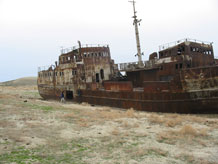What's the story behind the graph?
4. Connect mini-lakes and real lakes

Staecker, via Wikimedia Commons
Show students the images of the Aral Sea ships, and highlight the similarities and differences between the mini-lakes and real lakes:
- The evaporation process is the same for both, with particles of water too small to see moving into the air to become water vapor.
- In most real lakes, the water that leaves through evaporation or streams is replaced by water from streams and by rain and snow.
- The mini-lakes lost water through evaporation but none of that water was replaced.
Give each student a copy of Why are these ships in a field? The Story of the Aral Sea, and then read the story as they follow along. Next, read the Letter from the Engineer, "Engineering and the Aral Sea".
Letter from the Engineer
Engineering and the Aral Sea
When people decided to use water from the Amu and Syr Rivers for watering cotton fields, they turned to engineers with the question: How can we move water from the rivers away from the Aral Sea and toward land that will be used to grow cotton? The engineers understood the problem they were asked to solve, and they designed canals — very long ditches — that would carry water from the two rivers to the future cotton fields. Their solution worked very well for the cotton farmers. Lots of water from the rivers went into the new canals and to the cotton fields, and much less water went into the Aral Sea. Farmers were now able to grow cotton in places that had always been much too dry (not enough rain) to grow crops.
But the canals also created problems. As the water in the Aral Sea evaporated, it was no longer replaced by river water. Furthermore, the salt did not evaporate. So the sea became more and more salty and eventually the fish died. For the fishermen, the new canals were not a solution, they actually created a new problem. And when so much water evaporated that most of the old sea dried up, the winds blew dust and salt from the old sea bottom into the air. Many people who lived nearby inhaled salt and dust into their lungs and became ill, so the new canals were not a solution for them either.
Did the people who decided to send water to the cotton fields think the Aral Sea would just stay the same? Did they forget about evaporation?
Engineering projects can often make peoples’ lives better in some ways, but they can also cause new problems if people are not careful to think about everything that will change as a result of a new project. Can you think of some things that have been designed to make life easier in some way but that also created problems?
(Possible responses include disposable items such as plastic water bottles; cars; leaf blowers.)



